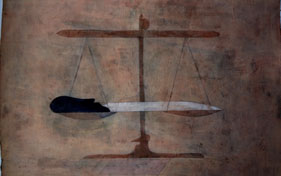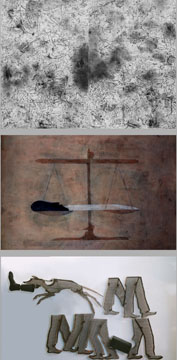| |
| |
| |
| |
|
|
 |
|
 |
| |
Many philosophies and world views
have a set of classical elements believed to reflect the simplest
essential parts and principles of which anything consists or upon
which the constitution and fundamental power of anything are based.
Most frequently, classical elements refer to ancient beliefs inspired
by natural observation of the phases of “matter”. They
are earth, air, water and fire.
“It Matters!”- indicates the existence of a thought,
a particle and a life and the reason behind it and points to issues
and existences which make the universe and its components complete.
This can be both tangible and intangible.
The exhibition hopes to strike a chord and inspire viewers to think
and reflect on the question of what really “matters”.
The interpretations can be open- ended, personal and subjective
to each artist. The exhibition brings together these diverse constructs
in one platform and draws attention to what “matters”
Exhibition organised in collaboration
with India International Centre |
|
|
| |
| |
 |
|
 |
| |
Born 1961, in Howrah,
West Bengal
Bachelor of Visual Arts in Printmaking, Rabindra Bharati University,
Kolkata (1987) ,Master of Visual Arts in Printmaking, Rabindra Bharati
University, Kolkata (1989) ,Coming from the Bengal school where
artists interrogate and reintegrate local styles into their work
consistently and directly, it is still unique to see Debnath’s
work include a piece emphasizing a letter from the Bengali scripts
as part of bringing out this local style.
|
|
| |
His recent work is has
been a mix collages using ink on paper, all in grey tonalities.
Viewers will find a human form that slowly emerges from these scribbles
and marks. His fundamental idea that the more that is hidden and
suppressed, the more his art must reveal and dismantle can be clearly
understood in his grey, dark and dense works. The bedlam of his
art gets a meaningful value when he writes these scripts/ texts
entirely by hand without employing any mechanical means on the paper
surfaces, often indecipherable because of its intentionally poor
visibility yet clear and legible when pored over carefully.
Debnath still draws inspiration about ideas and imageries of dominance,
repression and victimization, from a personal encounter he had with
the judicial system a decade back. He uses graphite dust procured
from local iron foundries, all retextualising his model for artistic
process. |
|
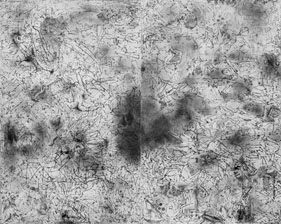 |
|
| |
Lives and works in Howrah, West Bengal.
India. |
|
|
|
|
| |
 |
|
 |
| |
Jayshree Chakravarty was
educated at Santiniketan and she graduated in Fine Arts from the
Viswa Bharati University, Santiniketan, in 1978 and obtained a post-graduate
diploma from M.S.University, Baroda, in 1980. She received a Canadian
grant in 1982 to study art. She later migrated to France and married
a French flautist.
|
|
| |
Chakravarty says, 'My
paintings are like a personal diary of my days in France and the
influences.' She has developed her own personal style, drawing on
inspiration from the French impressionists and Byzantine mosaic
design. The artist says that her
paintings are mostly autobiographical. "I have beenable to
reach out to those who have little to do with my personal life,"
shepoints out, "and make them identify with my deeply felt
imagery."Chakravarty's ink on paper sketches is an exercise
in transition and transforming personal experience into mystical
truth. She positions herself in the image of a spontaneous, instinctive
woman who is a muse and eternalchild rolled into one. |
|
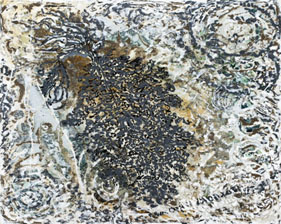 |
|
| |
Chakravarty says that
her paintings, either ink on paper or oils, have the feel of a dream
about them. She believes that relating to human beings of a distant
country and a different culture has expanded the horizons of herimagination
and forced certain pre-conceived images to change. In
her works, she uses superimposed forms, quite like the sketches
that cave painters worked on before they mapped them on the walls
of caves. Herimagery, because of her fluid and transparent images,
reflect the presentmood of the world, which is fluid in itself.
At a mere conventional andfigurative level, her works reflect
the unity of man with nature. |
|
|
| |
| |
| |
 |
 |
|
 |
| |
Reji's paintings exude a matter
of fact quality. His use of bold, slightly rounded figuration constructs
a naïve style reminiscent of Gauguin. Despite - or perhaps
because of - their apparent simplicity, his paintings are enigmatic
and the motifs he engenders are difficult to decipher. His work
is multifaceted and complex in its analysis of the individual's
relationship to his external environment. Often political in inflection,
his canvases explore the connection between psychological states
of mind and socio-political behavior.
|
|
| |
Born in Kerala, Reji completed
both B.F.A. and M.F.A in Painting from the Faculty of Fine Arts,
M.S. University, Baroda. Since then, he has participated in many
artist camps, exhibitions and workshops. In 2000 he held a solo
exhibition at Zen Studio Gallery and he has exhibited at 'Words
and Images', Guild Art Gallery, Mumbai, 2002 and 'Studio The Guild',
The Guild, Mumbai. K.P. Reji currently resides in Baroda |
|
 |
|
|
 |
|
 |
 |
 |
|
 |
| |
Sujith SN was born in Baroda in
1980. He spent his formative years in Gujarat before his parents settled
back in Palakkad in North Kerala. Sujith completed his B.F.A from
the Fine Arts College, Thrissur and went on to pursue a M.F.A in painting
at the Sarojini Naidu School of Fine Arts, Performing Arts and Communication,
University of Hyderabad in 2007. Sujith’s works have been part
of noted exhibitions in India and abroad.
|
|
| |
His recent shows include “Psalms
of Silence and Dark”, solo show, HSLU, Luzern, Switzerland (2012);
The Skoda Prize Twenty (2011-2012); “The Map is not the Territory”
at Latitude 28, New Delhi (2010); “Indian Subway” at Grosvenor
Vadehra Gallery, London (2010); “Earth” at Gallery OED,
Kochi, India (2010) and “The City and the Tower” which
was his first solo at Sakshi Gallery, Mumbai in 2008. Sujith has been
the recipient of many awards including the FICA Emerging Artist Award
2011; he was long listed for the Skoda Prize 2011. Sujith’s
recent works are inspired by the concept of “momento mori”,
a Latin phrase that translates to “remember your mortality”. |
|
 |
|
| |
The human condition therefore
becomes central to Sujith’s works. Urban panoramas and chaotic
development have also been themes that the artist has often delved
in. While his preferred medium of working is water colours, Sujith
also works with charcoals, oils and photography |
|
|
 |
 |
|
 |
| |
In each of Rajendran’s works
of art, the artist makes a ‘conscious decision’ to raise
awareness about the ‘sad state of affairs’ around him.
His sculptures amalgamate various fundamental forms such as animals,
objects and humans, resulting in hybrid species that break downs all
preconceived notions one may have while categorizing anything into
a ‘type’. His use of industrial materials such as ceramic
tiles, steel, iron and other unbending resources also breaks barriers
by transforming tough, primal materials into the organic forms that
make up his installations.
|
|
| |
Born in 1972 in Trivandrum, Kerala,
Sumedh Rajendran completed his Bachelor’s degree in Sculpture
from the College of Fine Arts there in 1994, and obtained his Master’s
degree from the Delhi College of Art in 1999. He has several solo
and group exhibitions to his credit.
Rajendran has also participated in various residencies across South
Asia including Khoj, New Delhi, and the Teertha International Artist
Residency, Colombo, Sri Lanka.
|
|
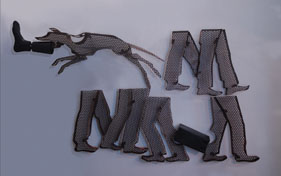 |
|
|
 |
|
 |
 |
|
 |
 |
|
 |
| |
Ahmed’s work is uncompromising,
yet his treatment of this subject is particularly nuanced. Mullah
figures are delicately painted like saints or princes, their features
refined, their expressions filled with inner peace. Around them, a
spiritual world of the anticipated paradise is symbolized by the Garden,
enriched by delicate calligraphy. Figures of covered women are everywhere.
It is a world of desire and fulfillment within the transient reality
of life on earth.
|
|
| |
The latter, however, is made of
mud and blood. Waseem Ahmed succeeds beautifully in presenting the
collision of these two contradicting worlds. He presents the current
compost of atrocities as a parallel psychological landscape to the
Paradise that is so violently desired. This is a landscape of desolation
and sublimation. The burqa becomes a camouflage for the suicide bomber;
individual figures are turned into bullets, personifying fear.
His language deliberately uses the precision of the Mughal classical
art on paper to suspend his subjects in this paradoxical present.
Waseem Ahmed’s work combines a traditional medium with controversial
subjects and reclaims the original function of miniatures: as chronicles
of contemporary social issues
|
|
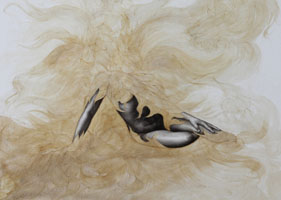 |
|
|
 |
 |







